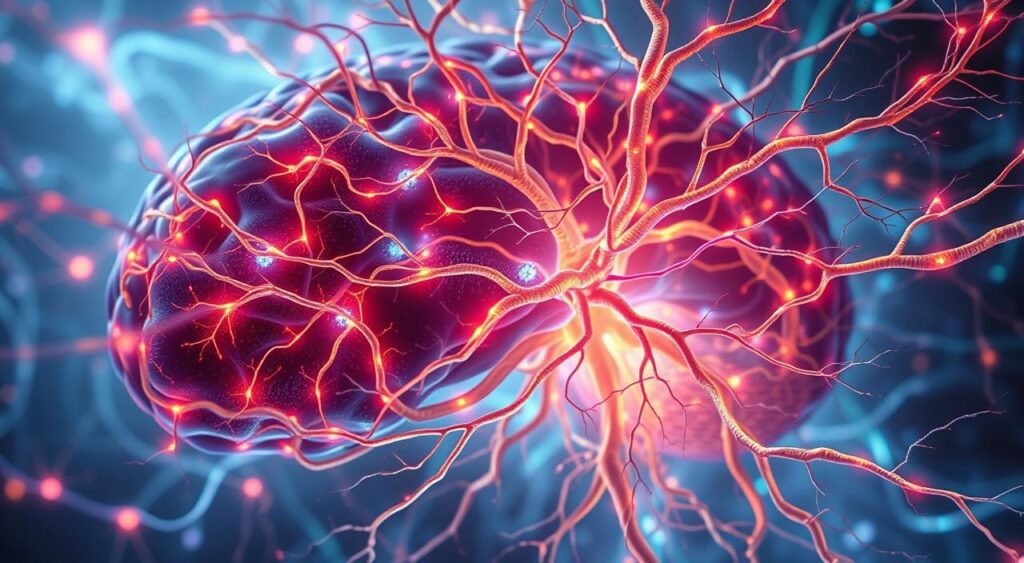About 1 in 100,000 people suffer from Acute Idiopathic Polyneuritis. It’s a rare condition that causes inflammation in the nerves. This leads to neuropathy and nerve damage. It greatly affects a person’s life, making it key to know about neurological disorders.
Managing Acute Idiopathic Polyneuritis needs a detailed plan. This includes understanding neuropathy and nerve damage. By learning more about it, people can handle the challenges of living with a neurological disorder.

It’s vital to understand Acute Idiopathic Polyneuritis well. This helps in finding better treatments and improving patient care. By exploring neurological disorders, we can appreciate the nervous system’s complexity and its role in our health.
Key Takeaways
- Acute Idiopathic Polyneuritis is a rare neurological disorder that affects the peripheral nerves.
- The condition can cause neuropathy and nerve damage, leading to significant lifestyle changes.
- Understanding the basics of neurological disorders is essential for effective management and treatment.
- Neuropathy and nerve damage can have a profound impact on an individual’s quality of life.
- Comprehensive treatment strategies are necessary to improve patient outcomes and manage the condition.
- Research and education are critical for advancing our understanding of Acute Idiopathic Polyneuritis and neurological disorders.
Understanding Acute Idiopathic Polyneuritis
Acute Idiopathic Polyneuritis, also known as Guillain-Barré Syndrome, is a rare condition. It affects the nerves in the body. This leads to muscle weakness and paralysis.
In neurology, Guillain-Barré Syndrome is seen as an autoimmune disorder. The immune system attacks the nerves by mistake. It can start after a viral or bacterial infection and gets worse fast.
Definition and Basic Concepts
The condition is known by its symptoms like muscle weakness and numbness. It’s about how the immune system damages nerves. This causes the symptoms we see.
Related Neurological Conditions
Guillain-Barré Syndrome is linked to other conditions like CIDP and MMN. These also involve nerve inflammation. But they differ in how they progress and how they’re treated.
| Condition | Symptoms | Treatment |
|---|---|---|
| Guillain-Barré Syndrome | Muscle weakness, numbness, tingling | Plasmapheresis, immunoglobulin therapy |
| CIDP | Muscle weakness, numbness, tingling | Corticosteroids, immunosuppressants |
| MMN | Muscle weakness, atrophy | Immunoglobulin therapy, physical therapy |
Knowing how these conditions are related helps in diagnosing and treating Acute Idiopathic Polyneuritis. It shows the key role of neurology in managing these complex disorders.
The Impact of Acute Idiopathic Polyneuritis on the Nervous System
Acute Idiopathic Polyneuritis can cause nerve damage. This leads to muscle weakness, sensory loss, and sometimes, breathing problems. It’s a neurological disorder that messes with how nerves talk to the brain and the rest of the body.
It’s important to know how this condition affects the nervous system. This knowledge helps doctors create better treatment plans. Rehabilitation is key in helping patients get better. It might include physical therapy, occupational therapy, and more.
- Physical therapy to improve muscle strength and mobility
- Occupational therapy to develop strategies for daily living
- Pain management to reduce discomfort and improve quality of life
By fixing the nerve damage and offering good rehabilitation, patients can see big improvements. It’s vital to work with a healthcare team to make a treatment plan that fits each patient’s needs.
Common Signs and Symptoms
It’s important to know the signs of Acute Idiopathic Polyneuritis to get help fast. Early symptoms include tingling or numbness in your hands and feet. If not treated, these can get worse, leading to muscle weakness and numbness.
If you notice these signs, you should see a doctor for neurological treatment. Knowing when to go to the emergency care is key. Look out for signs like trouble breathing, a fast heartbeat, or sudden weakness in your face, arm, or leg.
Initial Manifestations
The first signs of Acute Idiopathic Polyneuritis can differ for everyone. But often, you might feel mild weakness, tingling, or numbness in your hands and feet. As it gets worse, you might face:
- Muscle weakness or paralysis
- Numbness or tingling in the extremities
- Pain or cramping in the muscles
Progressive Symptoms
Without treatment, the symptoms can get worse. You might feel more muscle weakness, numbness, and even paralysis. If you notice any of these, get medical help right away. Severe breathing trouble, a fast heartbeat, or sudden weakness in your face, arm, or leg are emergencies.
Severe difficulty breathing, rapid heartbeat, or sudden weakness in the face, arm, or leg, as these can be life-threatening and require immediate emergency care.
Emergency Warning Signs
Here are the emergency signs that need quick medical help:
| Symptom | Description |
|---|---|
| Severe difficulty breathing | Shortness of breath or inability to breathe |
| Rapid heartbeat | Abnormally fast heart rate |
| Sudden weakness | Weakness or paralysis in the face, arm, or leg |
Getting medical help fast is key to avoid lasting damage and get the right treatment. Knowing the signs of Acute Idiopathic Polyneuritis is the first step to recovery and managing the condition.
Risk Factors and Triggers
Understanding the risk factors and triggers for Acute Idiopathic Polyneuritis is key for neurological health. The exact cause is still unknown. But, some factors can make people more likely to get the condition. These include recent infections, vaccinations, and other health issues.
Some common triggers include:
- Recent viral or bacterial infections
- Certain vaccinations
- Autoimmune disorders
- Family history of neurological conditions
These factors can harm the nervous system, causing Acute Idiopathic Polyneuritis. Knowing these risk factors and triggers helps manage and prevent the condition.
Keeping your neurological health in check is crucial. By understanding the risk factors and triggers, you can protect your nervous system and health.
| Risk Factor | Description |
|---|---|
| Recent Infections | Recent viral or bacterial infections can trigger the onset of Acute Idiopathic Polyneuritis |
| Vaccinations | Certain vaccinations may be associated with an increased risk of developing the condition |
| Autoimmune Disorders | Autoimmune disorders can increase the risk of developing Acute Idiopathic Polyneuritis |
Diagnostic Process and Testing Methods
To diagnose Acute Idiopathic Polyneuritis, a detailed evaluation is needed. This includes physical exams, lab tests, and special tests like nerve conduction studies. These tests help find out how much nerve damage there is.
A physical exam is the first step. Then, lab tests are done to check for other possible causes. Nerve conduction studies measure how well nerves send signals. This shows if there’s any nerve damage.
- Electromyography (EMG) to check muscle electrical activity
- Imaging tests like MRI or CT scans to look for other issues
- Blood tests to find out if there’s an underlying condition
Healthcare professionals use these tests to find the right diagnosis. They then create a treatment plan to help manage the condition. This plan might include medicine, physical therapy, and changes in lifestyle.
Treatment Approaches and Medical Interventions
Acute Idiopathic Polyneuritis needs a detailed treatment plan. It includes different medical steps and ways to help the body heal. The main aim is to control symptoms, lessen swelling, and boost nerve health. The treatment plan changes based on how severe the condition is and the person’s health.
First, doctors give medicines to cut down swelling and pain. For long-term care, they might use treatments to calm the immune system. Physical therapy is also key, helping to get back function and movement.
Rehabilitation Options
Rehab is a big part of treating Acute Idiopathic Polyneuritis. It includes occupational, speech, and physical therapy. These help people get back to doing things on their own and improve their life quality. Each person’s treatment and rehab plan should be made just for them, and it should keep going to help them get better.

Changing your lifestyle can also help with treatment. Eating well, drinking plenty of water, and exercising regularly can help symptoms. By using these methods together, people with Acute Idiopathic Polyneuritis can manage their condition better and have a good chance of getting better.
Recovery Timeline and Prognosis
The time it takes to recover from Acute Idiopathic Polyneuritis varies a lot. Neurological recovery depends on many things. These include how bad the condition is, how well treatment works, and the person’s health.
People usually see slow recovery over months. Some get better fully, while others face lasting disabilities.
Things that affect prognosis include how much nerve damage there is, any other health issues, and the person’s age. Getting treatment early and effectively can lead to a better prognosis. Some might fully recover, while others need ongoing care and rehab to deal with symptoms.
Knowing what to expect and the prognosis helps patients and their families prepare. Working with doctors and sticking to a treatment plan can improve chances of a good neurological recovery.
Living with Acute Idiopathic Polyneuritis: Management Strategies
Managing neuropathy requires a full approach. This means making daily changes, getting support, and focusing on mental health. These steps help people deal with neuropathy’s challenges.
Managing neuropathy involves lifestyle changes and professional help. For example, physical therapy can improve movement and lessen pain. Occupational therapy helps with daily tasks and keeps people independent.
Important things to consider when living with neuropathy include:
- Daily exercise to keep mobility and strength
- Healthy eating to support nerve health
- Stress management techniques to reduce anxiety and depression
- Regular check-ups with healthcare professionals to monitor condition progression
Support systems and resources are key for emotional and psychological well-being. Joining support groups, seeking counseling, or using online forums can help. Connecting with others who understand can offer comfort, guidance, and motivation.
Mental health is crucial when living with neuropathy. The condition can lead to anxiety, depression, and stress. Recognizing mental health’s importance and seeking help when needed can improve life quality.

A holistic approach to management helps navigate neuropathy’s challenges. This includes daily adaptations, support, and mental health focus. With the right strategies, people can enhance their life quality and lessen the condition’s impact.
| Management Strategies | Benefits |
|---|---|
| Daily exercise | Improves mobility and strength |
| Healthy eating | Supports nerve health |
| Stress management | Reduces anxiety and depression |
Conclusion
Acute Idiopathic Polyneuritis is a complex condition that affects neurological health. It needs comprehensive management and care. We’ve looked at its definition, symptoms, diagnosis, treatment, and living with it.
Understanding Acute Idiopathic Polyneuritis helps patients and caregivers face its challenges. This improves outcomes and quality of life.
Neurological health is key, especially for those with Acute Idiopathic Polyneuritis. Quick medical attention and ongoing care are vital. We need more research and awareness to help those affected.
Our discussion on Acute Idiopathic Polyneuritis shows the importance of a well-informed approach. Recognizing the impact on neurological health is crucial. This leads to better care and support for those affected.
FAQ
Q: What is Acute Idiopathic Polyneuritis?
A: Acute Idiopathic Polyneuritis is a rare condition affecting the nerves. It causes inflammation and damage. This leads to muscle weakness, numbness, and sometimes paralysis.
Q: What are the common signs and symptoms of Acute Idiopathic Polyneuritis?
A: Symptoms include muscle weakness, numbness, and tingling. In severe cases, it can cause respiratory failure. It’s important to recognize these symptoms early for proper treatment.
Q: How is Acute Idiopathic Polyneuritis diagnosed?
A: Doctors use physical exams, lab tests, and nerve studies to diagnose it. These tests help confirm the condition and rule out other diseases.
Q: What are the treatment options for Acute Idiopathic Polyneuritis?
A: Treatment aims to manage symptoms and improve nerve function. It includes immunotherapy, physical therapy, and rehabilitation. These help restore function and mobility.
Q: What is the recovery timeline and prognosis for Acute Idiopathic Polyneuritis?
A: Recovery times vary. Some may fully recover, while others may have lasting disabilities. Age, health, and symptom severity play a role in the prognosis.
Q: How can individuals living with Acute Idiopathic Polyneuritis manage their condition?
A: Managing the condition requires daily life adjustments and support. It’s also important to address mental health. This holistic approach helps improve overall health.
Q: What are the risk factors and triggers for Acute Idiopathic Polyneuritis?
A: The exact cause is unknown, but some factors increase risk. These include recent infections and vaccinations. Certain medical conditions may also play a role.
Q: Is Acute Idiopathic Polyneuritis related to other neurological conditions?
A: Yes, it’s linked to conditions like Guillain-Barré Syndrome. Understanding these connections helps in managing and treating the condition.
